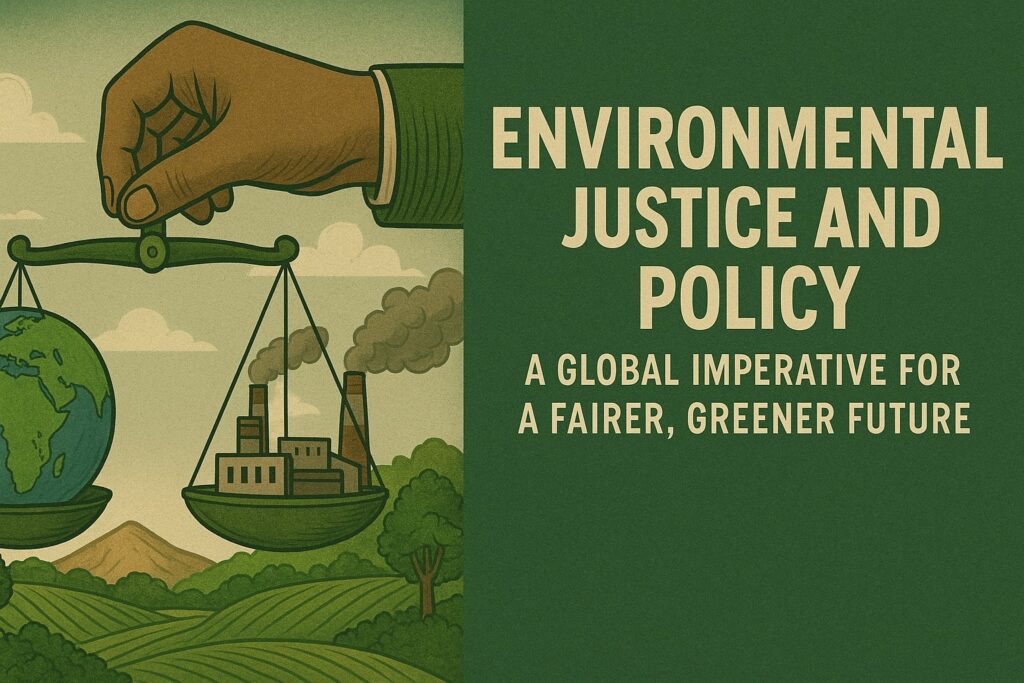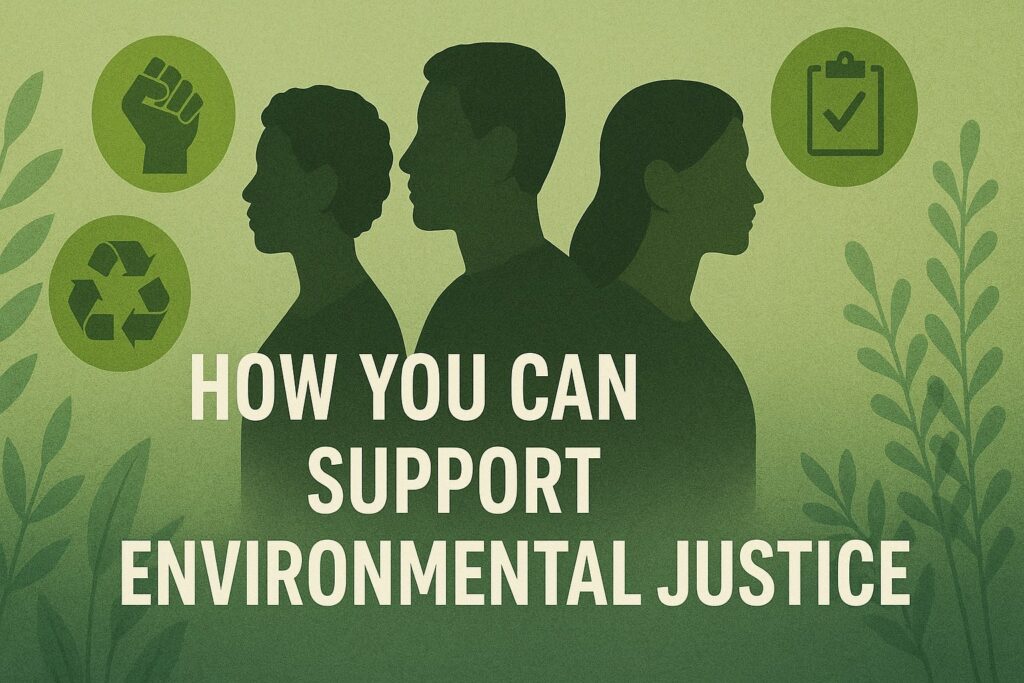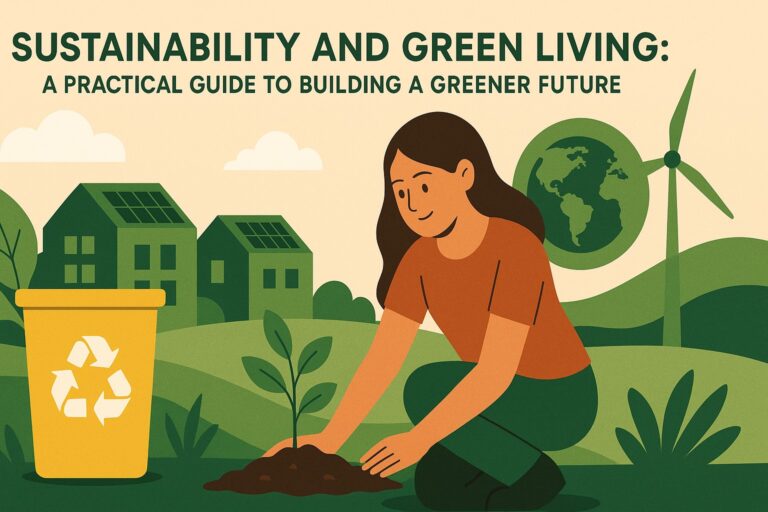Environmental Justice and Policy: A Global Imperative for a Fairer, Greener Future: An Urgent need 2025

“Environmental justice is not just about the environment-it about people. It’s about dignity. It’s about equity.”
The damage we do to the planet does not land evenly. Dark smoke hangs over busy, low-income neighbourhoods, while coastlines that poor island families call home slowly slip below wave after wave. Too often, those who did the least to cause the problem feel the blow first and hardest.
That imbalance sits at the heart of environmental justice.
It says that caring for nature and caring for people must walk hand in hand. When a new mine opens, a highway stretches through a community, or a forest is locked away as a park, everyone who gains and everyone who loses should be known, listened to, and treated fairly.
With the climate clock ticking louder, species fading by the hour, and fresh water growing scarce, its clear that justice can no longer be packed away as a nice-to-have. To talk about being sustainable at all, we must first talk about being fair.
Globally, the linked crises of ecological damage and social inequality are deepening, making one thing painfully clear: harm to the environment is never evenly shared. People who pollute the least—including many low-income, Indigenous, and otherwise marginalised groups—often bear the brunt of poisons in the air, tainted water, fierce storms, or forced relocation.
This cruel imbalance sits at the centre of the environmental-justice movement, which demands that everyone, no matter their race, wealth, location, or passport colour, enjoys a clean, safe, and healthy surrounding. Advocates now treat the fight to save nature as part-and-parcel of the wider push for fairness and human dignity. With temperatures rising, species disappearing, and resources growing thinner by the day, the call for climate policy that puts justice first feels less like a choice and more like the most pressing emergency on Earth.
Environmental justice starts by admitting that the benefits and burdens of growth-even clean-growth-were never shared evenly. Around the world, smoke-spewing factories, massive landfills, and giant fossil-fuel plants are repeatedly built near low-income and racially marginalized neighborhoods, while well-off communities get to keep the pollution at arm’s length. Residents in these targeted areas rarely have the spare time, money, or political muscle to push back, so they find themselves stuck in a grim cycle of poor health, shaky jobs, and eroding local culture for decades or longer.
Meanwhile, richer households enjoy fresher air, steady water, and green parks, often staying blissfully unaware that their privilege rests on sending waste and danger somewhere else-even across national borders. None of this happened by accident; it springs from long-standing social hierarchies that shape laws, market rules, and who decides how public dollars get spent.
Real environmental justice calls for a fresh look at policy-making, an open seat for the people who are hurt most, and a clear breakdown of who pays for the green rules and who enjoys the benefits.
Taking this path means stopping harm today, of course, but it also means _building a tomorrow that works better for everybody. _The idea is to put long-ignored neighborhoods at the centre of every plan, direct money into parks, solar roofs and green buses, and strengthen local groups so they can ride out floods and heat waves. It asks governments to honour treaties with Indigenous nations and listen to grassroots leaders who have cared for land and water for decades.
The movement also calls for a clean-energy switch that _gives fossil-fuel workers new training and fair jobs _while easing troubled regions into the change slowly. On the world stage, it demands that rich countries back poorer ones so nations that warmed the planet least do not drown under its worst storms.
This article digs into how _environmental justice shows up in rules made close to home, across the country, and around the globe, from city climate plans that protect the hardest-hit blocks to international funds that keep low-income countries afloat.
After looking at real wins and losses in the field, listening to local groups pushing for clear answers, and laying out specific steps for lawmakers, organizers, and everyday folks, we want to pair useful how-to tips with solid analysis. In short, we say that environmental justice is not an add-on or side dish; it has to be the solid foundation of any serious, fair, and lasting plan to tackle the global crisis. When everyone from businesses to communities to governments treats this idea as central, we can build a future where nature can bounce back and every person-especially those who have been left out-feels safe, respected, and able to seize new chances for the next hundred years.
In this post well look at:
What environmental justice really means ?
Why the whole World has a stake in it ?
Real stories of harm, hope, and victory
The power of policy to turn ideals into rules
Small steps you can take today for a fairer, greener tomorrow
What is Environmental Justice?
At its simplest, environmental justice means: Fair treatment of all people in environmental policy and decision-making.
Meaningful involvement of all communities in shaping the rules that affect them.
Good laws are those created together, not handed down from above.
It recognises that:
Pollution, toxic waste and big resource projects tend to land first, and hardest, on poorer, often invisible, neighbourhoods.
Race, class and where a person lives usually decide who breathes clean air, drinks safe water or strolls in real greenery.
Making the planet greener while ignoring these divides is like sanding a rotten table leg, the rot will still break through.
Nothing less than fair access to a healthy environment is therefore what the movement demands for everyone, no matter income, skin colour or passport.

Why Does Environmental Justice Matter for Everyone?
Environmental justice may sound like a local fight, yet its ripples touch every seat in the classroom, every corner of our shared home.
Here is why it matters to everyone on Earth:
The Climate Crisis Is Inherently Unfair
Wealthy nations have burnt fossil fuels longest and released most of the carbon.
Low-income nations that did the least heating now face the fiercest storms, droughts and ruined crops.
More people will soon join the ranks of climate refugees, moving not by choice but by survival.
Pollution Doesn’t Respect Borders
Smoke and sewage travel on wind and river currents, leaving neighbours little choice.
An ocean full of plastic from one port will bash the sandy shores of another coastal village.
Mercury spewed in one industrial zone finds its way into fish dinner plates Worldwide.
Inequality Fuels Instability
Scarce resources, polluted land and deepening poverty often spark protests and violence.
Resource wars, land grabs, and forced migrations threaten peace.
Solutions must be fair to succeed.
Top-down policies that ignore equity fail or face resistance.
Lasting change requires buy-in from all communities.
Simply put: a sustainable future is impossible without a just one.
Examples of Environmental Injustice Around the World
To see why environmental justice is urgent, look at real-world cases:
Flint, Michigan, USA
A city with a majority Black population and high poverty levels faced lead-contaminated drinking water due to cost-cutting and neglect. It was not a natural disaster-it was a policy failure that would never have been tolerated in wealthier, whiter communities.
Oil Extraction in the Niger Delta, Nigeria
For decades, oil spills and gas flaring have devastated local land and water. Fishing and farming collapsed. Health impacts are severe. Local communities see little benefit while oil companies and governments profit.
Pacific Island Nations
Countries like Tuvalu and Kiribati face existential threats from rising seas, despite contributing almost nothing to global emissions. They are forced to fight for survival on the global stage, demanding climate action from high-emitting nations.
Indigenous Land Grabs
Across forests in the Amazon, the Congo Basin, and Southeast Asia, mining, farming, and logging push Indigenous peoples off their ancestral land.
Those same areas shelter rare plants and animals and lock away tons of carbon. Evicting their long-time guardians hurts local families and the climate.
These cases are not one-offs. They fit a painful pattern of sacrifice zones where the poorest pay so other people can consume.

Examples of Environmental Justice Done Right
There is good news, though. Communities from many continents are standing up and actually winning.
The Environmental Justice Movement in the U.S.
Black, Latino, and Indigenous neighbourhood’s first joined forces to block toxic dumps near their homes. Their work brought Executive Order 12898, which makes federal agencies consider fairness in every project.
Ecuador’s Rights of Nature
Ecuador rewrote its Constitution to say nature has rights. Indigenous groups lean on that clause to challenge damaging mines and roads in court.
Kenya’s Green Belt Movement
Founded by Wangari Maathai, the movement urged women to plant trees, heal soil, and push leaders for cleaner politics.
India’s Chipko Movement
Villagers, mostly women, literally wrapped their arms around trees to stop loggers. Their stand led to nationwide forest protection rules.
These wins prove that real policy change happens when people organize, raise their voices, and refuse to back down.
The Role of Policy in Achieving Environmental Justice
Environmental justice isn’t just about recycling or buying organic food. It needs big, structural change. That kind of change only happens when lawmakers write rules that protect everyone. Here’s how smart policy can push environmental justice forward:
Enforcing Environmental Standards Equitably
Stop siting toxic factories and landfills in low-income or minority neighbourhoods.
Set strict pollution limits that cities, farms, and industries must follow—everywhere.
Ensuring Meaningful Participation
Invite residents most affected by pollution to help shape local plans.
Honour and use the traditional knowledge that Indigenous and rural communities hold.
Funding Clean-ups and Restoration
Direct cleanup money first to neighbourhood’s that suffered the most damage.
Make polluting companies foot the bill, rather than taxpayers.
Transitioning to Clean Energy Fairly
Protect jobs for workers who depend on coal, oil, and gas, so no one gets pushed aside.
Channel resources into green training programs and community-owned solar and wind projects.
Protecting Vulnerable Nations
Honour pledges of climate finance to help poorer nations adapt and recover from loss.
Give small-island states and developing countries real seats at every climate table.
Recognizing Rights of Nature and Indigenous Land
Write laws that treat rivers, forests, and ecosystems as living entities with legal standing.
Return control of lands to Indigenous nations, supporting their historic stewardship.
Policy isn’t a luxury. It’s the toolbox we need to turn good intentions into lasting justice.
Why This Fight Needs Global Cooperation
Environmental justice plays out in backyards, yet its roots cross borders. No single city or country can end climate change, air poison, or plastic waste alone. We must share solutions, technologies, and money, especially with those who suffer most. Wealthy nations have to cut their own emissions first and deepest. If rich countries lead with bold rules, we all gain cleaner air, safer futures, and fairer economies.
Steps Toward Global Climate Justice
Nations must agree on fair trade rules and share resources
Countries should set clear, equitable rules for trade and natural resources so that no one profits while others pay the price.
Rich nations must fund clean, just transitions in poorer ones
Wealthy governments and businesses must invest money and tech in low-and middle-income countries, helping them skip polluting phases and thrive fairly.
Global agencies like the UN must lift voices from hardest-hit communities
United Nations and similar groups need to listen first to people already living with extreme floods, heat waves, and toxic waste and put their needs at the centre of all decisions.

How YOU Can Support Environmental Justice
Wondering how to help? Here are practical, meaningful ways:
Learn and Listen
Read about local and global struggles.
Centre voices of frontline communities.
Advocate for Policy Change
Support laws that cut pollution and share the cost fairly.
Demand climate plans that protect the most vulnerable first.
Vote with Justice in Mind
Back candidates who treat environmental justice as a must, not a talking point.
Expose greenwashing ads and hold sponsors accountable.
Reduce Your Own Footprint
Cut waste, use public transport, and eat lower-impact foods where you can.
Remember that every extra plastic bottle, fast flight, and cheap gadget pushes pollution onto those with the least power to fight it.
Support Organizations on the Front Lines
Give money or hours to groups led by affected communities, like frontline farming unions or Indigenous land defenders.
Share their achievements and urgent appeals across social media.
Talk About It
Bring environmental justice into everyday chats with friends, family, and colleagues.
Push local boards, clubs, or schools to make it part of their own green plans.
Conclusion: A Call to Conscience and Action
Environmental justice is not just an environmental issue—it’s a human rights issue
It demands we ask hard questions: Who benefits from today’s economies? Who pays with their health, land, or even lives? And will we act together, in time, so that the clean future we promise protects everyone?
Answering yes means challenging comforts, but it can also mean unleashing the creativity, fairness, and spirit that only a truly just movement can inspire.
Who gets the good stuff?
Who pays the price?
Who calls the shots?
These questions push us to picture a planet where every person- no matter their colour, wallet size, or passport- enjoys fresh air, clean water, and basic respect.
They also teach us that a fairer World isn’t just a nice bonus for the planet-saving mission; it is the mission. If we leave anyone behind, we weaken the whole effort.
Luckily, every one of us can pitch in, from swapping light bulbs to marching in big crowds.
Environmental justice is no longer a peripheral concern—it is a global imperative. As the world faces accelerating climate change, biodiversity loss, and environmental degradation, the unequal distribution of these burdens has become increasingly apparent. Marginalized and vulnerable communities often bear the brunt of pollution, resource depletion, and climate disasters, despite contributing the least to these crises. Addressing environmental injustice is not just an ethical obligation; it is a prerequisite for achieving sustainable development and global stability.
To be effective, environmental rules must welcome every voice, especially those who have long been shut out of boardrooms and government offices. That call for fairness goes beyond quick fixes-it calls for overhauling agencies, applying laws without favoritism, shining light on hidden deals, and honoring the land rights of Indigenous peoples and local communities. Accountability for polluters has to be real, and money must flow into green projects that help, not push, people from their homes.
In the end, environmental justice and policy go hand in hand. We will build a truly green future only if fairness is built into every step of how we protect the planet. That means hearing the voices most affected, taking real action, and changing laws so that natures shield covers everyone, not just the well-off. The moment to bring together justice and sustainability is here. What we choose to do today will shape tomorrows world for better or worse.
Come on, let’s join forces and build a cleaner, fairer, and kinder world for every person

Read My Publications or visit my LinkedIn



It’s need to modern man effectively
Absolutely spot on. We can’t have climate solutions without justice at the center. Thanks for this powerful reminder!
Thanks for sharing such a thoughtful piece. It’s crucial we talk about who pays the highest price for environmental damage. Keep writing on this vital topic!
Really important message here. We all need to take responsibility and advocate for fairer, greener policies. Sharing this with my friends today